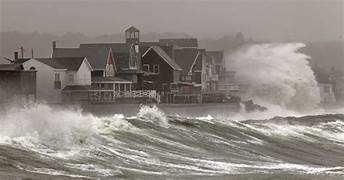On October 30, 2012, Hurricane Sandy, also known as Superstorm Sandy, made landfall on the United States' East Coast. This massive storm wreaked havoc, causing widespread destruction and devastation along its path, particularly in states such as New York and New Jersey. The impacts of Hurricane Sandy serve as a stark reminder of the destructive power of nature and the need for effective disaster preparedness and response. Hurricane Sandy originated in the Caribbean before intensifying as it moved northward along the East Coast of the United States. It merged with a cold front and transformed into a hybrid storm, resulting in an unprecedented combination of hurricane-force winds, heavy rainfall, and storm surges. The storm's immense size and strength made it one of the most destructive hurricanes in the region's history. As Hurricane Sandy made landfall, it brought destructive winds, heavy rainfall, and massive storm surges that inundated coastal areas. The storm surge, exacerbated by high tide, caused extensive flooding in low-lying areas, including parts of New York City, New Jersey, and other coastal regions. The flooding damaged homes, infrastructure, and transportation systems, leaving thousands of people stranded and without power. The impact on New York City was particularly severe, with significant flooding in lower Manhattan and other low-lying areas. The city's subway system was inundated, causing widespread disruption to transportation. Iconic landmarks such as Battery Park, the South Street Seaport, and parts of the Staten Island coastline were severely damaged. In New Jersey, coastal communities like Atlantic City and the Jersey Shore bore the brunt of the storm's fury. The storm surge caused extensive damage to homes, businesses, and iconic boardwalks. Entire neighborhoods were left submerged, and many residents were displaced from their homes. The devastation caused by Hurricane Sandy prompted a massive response effort from both government agencies and volunteer organizations. Emergency services, including the National Guard, were deployed to affected areas to assist with rescue operations, provide essential supplies, and restore critical infrastructure. The Federal Emergency Management Agency (FEMA) played a vital role in coordinating disaster response and providing support to affected communities. The long-term recovery process following Hurricane Sandy was challenging and required significant resources and time. Communities had to rebuild homes, repair infrastructure, and revitalize local economies. Lessons learned from this disaster led to improvements in disaster preparedness and response, as well as efforts to enhance coastal resilience and reduce vulnerability to future storms. Hurricane Sandy serves as a reminder of the importance of effective disaster planning, emergency response, and resilience measures. The storm highlighted the need for robust infrastructure, early warning systems, and community preparedness to mitigate the impacts of future disasters.
30 Oct, 2012 Hurricane Sandy Devastates US East Coast
